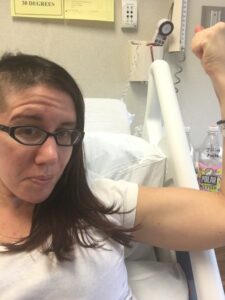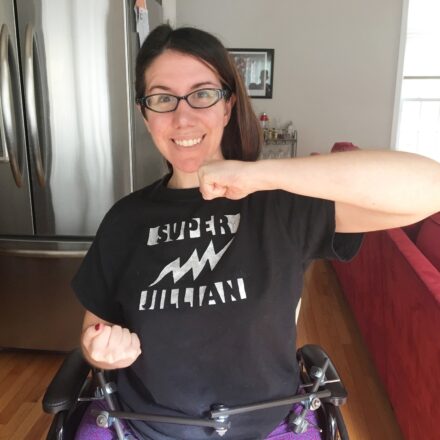By Jillian Kaplan, Telecom and 5G Thought Leadership, Dell Technologies
Early on the morning of August 10th, 2016, I made the seemingly small choice to walk my dog along my regular route. On any other day, I would have been home in 30 minutes’ time, but that day I didn’t make it back.

I was about five minutes from home when I was hit on a crosswalk by a distracted driver traveling at 40mph. At the time, I was waiting for a car to stop so I could cross safely but, according to bystanders, another car from the opposite direction rammed right into me.
I was unconscious and badly broken. To this day, I don’t remember the impact or the feeling of being thrown into the air with force (thank goodness), but I do know that I was taken to a level one trauma center where I had emergency brain surgery to save my life. My face, sternum, pelvis and sacrum were also shattered and it took multiple surgeries to piece me back together. The emotional scars have taken longer to heal.
I spent a week in the ICU, a month in the hospital and three months completely wheelchair-bound. I remember thinking to myself that I had two choices: I could fight to regain my life or I could accept my new reality as it was. In that moment, everything changed, and I decided I would not let the crash define me.
To put that declaration into context, the odds of surviving a crash like mine are about 1/10. The chances of me sitting here, writing this, are close to non-existent.
Making road safety my mission

I defied the odds. Many others are not so fortunate, which is why I have dedicated my second chance at life to instigating change that keeps pedestrians and drivers as safe as possible.
During my recovery, I met so many amazing people and connected with a non-profit that was fighting to pass a bill in Massachusetts penalizing drivers for holding a cell phone while operating a car. I testified multiple times and gave countless interviews in support of the legislation. Finally, in November 2019, I witnessed the Massachusetts governor sign the hands-free bill into law. It was a momentous day.
But more than two years after the law passed, we haven’t seen a substantive reduction in car crashes. In fact, according to CDC data, it’s hardly made a dent. In Massachusetts, vehicle crash deaths have remained approximately the same.
De-risking human behavior with technology
With the legislation falling short of the desired impact, I started thinking about how technologies like automation could help. At first, I was skeptical about autonomous vehicles. What if they malfunctioned and killed someone?
Putting human lives in the hands of autonomous cars is definitely risky but the more I researched, the more I concluded that these vehicles prevent far more crashes and deaths than they cause. I was also struck by the observation that too often we strive for 100%, but what if near-perfection is far better than accepting the status quo?
It takes a minimum of 1.5 seconds for a driver to react to a hazard. At 55 mph, a vehicle would travel 120 feet farther in that time and that’s if the driver was paying perfect attention. If technology exists that responds in a fraction of the time, it behooves us to give it a proper try.
And if software can be constantly updated and iterated, shouldn’t we commit to a solution that solves for human error, and can be tweaked and course-corrected over time? Isn’t that the well-trodden path to progress?
Safeguarding employees on the factory floor
My research led me to investigate the benefits of intelligent automation in other fields–particularly in manufacturing, where robotics are prevalent.
U.S. manufacturers reported over 370 thousand nonfatal workplace injuries and illnesses in 2020. These injuries can ruin lives and livelihoods as well as hurt the companies’ bottom line. The use of technology to improve health and safety can prevent many of them.
More than eight in 10 manufacturers around the world agree. According to Dell Technologies’ Breakthrough study, manufacturing respondents believe increasing automation in the workplace would enable them to mitigate (costly) human error.
The capstone technologies are 5G and edge: They allow rapid data transfers on the factory floor and on the road. The 5G infrastructure for autonomous cars is still a work in progress, but manufacturers can leverage private 5G within its four walls.
That said, in a recent podcast with technology futurist Bernard Marr, Todd Edmunds, Dell Technologies’ Global CTO of Industrial IoT and Edge Computing cautioned that many manufacturers won’t realize the many benefits of Edge and 5G because they’ve approached proof-of-concept development the wrong way round.
“They typically go about this from a use-case point of view,” Edmunds observed. “They think right, here’s a proof-of-concept, let’s put a computer somewhere, run an app on our factory floor, and we have proven the concept. The problem is only 30% [of businesses] have successfully scaled past that point…you really need to consider the foundation and look to deploy an enterprise-grade edge infrastructure approach and build that out first.”
Similarly, Edmunds believes many manufacturers will struggle to develop digital twins, which are built on data at the edge to allow machines to simulate millions of different situations, circumstances and outcomes to perfect a prototype before it goes into production. And they’re likely to miss out on private 5G slicing that enables manufacturers, for instance, to ringfence portions of the network for computer vision-powered automated safety cameras. The network management opportunities of private 5G are infinite, which is why it’s so important that we come alongside the 49% of manufacturers who, according to the Dell Breakthrough study, worry the opportunity to become a data-driven business will pass them by.
Where there is technology that drives human progress, there is hope
As I suggested earlier, the connective fabric for the open road, public 5G, isn’t in place yet. Telecommunication companies have ambitious roll-out plans, but there are a whole host of infrastructure challenges to overcome first.
It will happen, just not tomorrow. But that prospect is enough for me. It gives me the drive I need to be part of the breakthrough solution. I’m fortunate it’s also a core part of my job at Dell Technologies because I get to help bring technology to market that could make our roads and factories safer and, ultimately, save lives.

